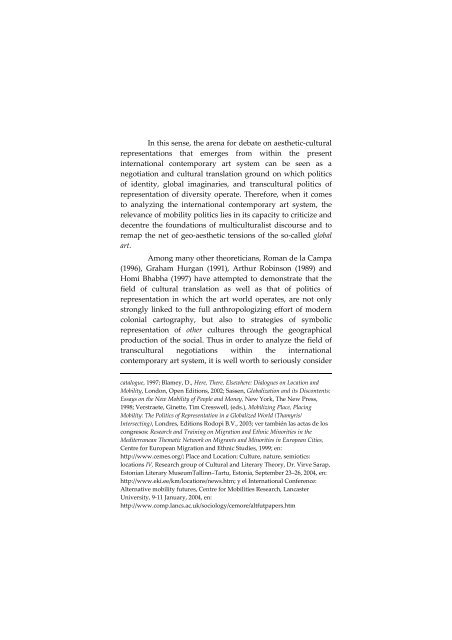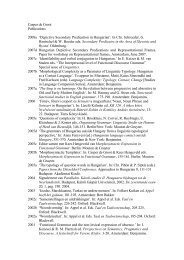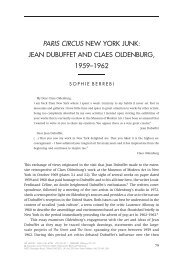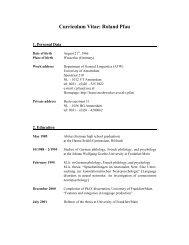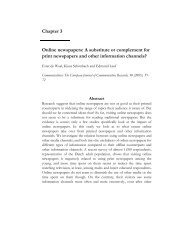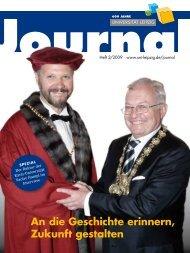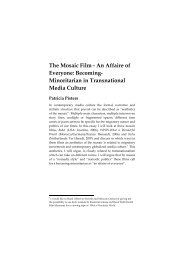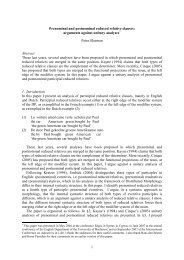Global Art And Politics Of Mobility: (Trans)Cultural Shifts in the ...
Global Art And Politics Of Mobility: (Trans)Cultural Shifts in the ...
Global Art And Politics Of Mobility: (Trans)Cultural Shifts in the ...
Create successful ePaper yourself
Turn your PDF publications into a flip-book with our unique Google optimized e-Paper software.
In this sense, <strong>the</strong> arena for debate on aes<strong>the</strong>tic-cultural<br />
representations that emerges from with<strong>in</strong> <strong>the</strong> present<br />
<strong>in</strong>ternational contemporary art system can be seen as a<br />
negotiation and cultural translation ground on which politics<br />
of identity, global imag<strong>in</strong>aries, and transcultural politics of<br />
representation of diversity operate. Therefore, when it comes<br />
to analyz<strong>in</strong>g <strong>the</strong> <strong>in</strong>ternational contemporary art system, <strong>the</strong><br />
relevance of mobility politics lies <strong>in</strong> its capacity to criticize and<br />
decentre <strong>the</strong> foundations of multiculturalist discourse and to<br />
remap <strong>the</strong> net of geo-aes<strong>the</strong>tic tensions of <strong>the</strong> so-called global<br />
art.<br />
Among many o<strong>the</strong>r <strong>the</strong>oreticians, Roman de la Campa<br />
(1996), Graham Hurgan (1991), <strong>Art</strong>hur Rob<strong>in</strong>son (1989) and<br />
Homi Bhabha (1997) have attempted to demonstrate that <strong>the</strong><br />
field of cultural translation as well as that of politics of<br />
representation <strong>in</strong> which <strong>the</strong> art world operates, are not only<br />
strongly l<strong>in</strong>ked to <strong>the</strong> full anthropologiz<strong>in</strong>g effort of modern<br />
colonial cartography, but also to strategies of symbolic<br />
representation of o<strong>the</strong>r cultures through <strong>the</strong> geographical<br />
production of <strong>the</strong> social. Thus <strong>in</strong> order to analyze <strong>the</strong> field of<br />
transcultural negotiations with<strong>in</strong> <strong>the</strong> <strong>in</strong>ternational<br />
contemporary art system, it is well worth to seriously consider<br />
catalogue, 1997; Blamey, D., Here, There, Elsewhere: Dialogues on Location and<br />
<strong>Mobility</strong>, London, Open Editions, 2002; Sassen, <strong>Global</strong>ization and its Discontents:<br />
Essays on <strong>the</strong> New <strong>Mobility</strong> of People and Money, New York, The New Press,<br />
1998; Verstraete, G<strong>in</strong>ette, Tim Cresswell, (eds.), Mobiliz<strong>in</strong>g Place, Plac<strong>in</strong>g<br />
<strong>Mobility</strong>: The <strong>Politics</strong> of Representation <strong>in</strong> a <strong>Global</strong>ized World (Thamyris/<br />
Intersect<strong>in</strong>g), Londres, Editions Rodopi B.V., 2003; ver también las actas de los<br />
congresos: Research and Tra<strong>in</strong><strong>in</strong>g on Migration and Ethnic M<strong>in</strong>orities <strong>in</strong> <strong>the</strong><br />
Mediterranean Thematic Network on Migrants and M<strong>in</strong>orities <strong>in</strong> European Cities,<br />
Centre for European Migration and Ethnic Studies, 1999; en:<br />
http://www.cemes.org/; Place and Location: Culture, nature, semiotics:<br />
locations IV, Research group of <strong>Cultural</strong> and Literary Theory, Dr. Virve Sarap,<br />
Estonian Literary MuseumTall<strong>in</strong>n–Tartu, Estonia, September 23–26, 2004, en:<br />
http://www.eki.ee/km/locations/news.htm; y el International Conference:<br />
Alternative mobility futures, Centre for Mobilities Research, Lancaster<br />
University, 9-11 January, 2004, en:<br />
http://www.comp.lancs.ac.uk/sociology/cemore/altfutpapers.htm


